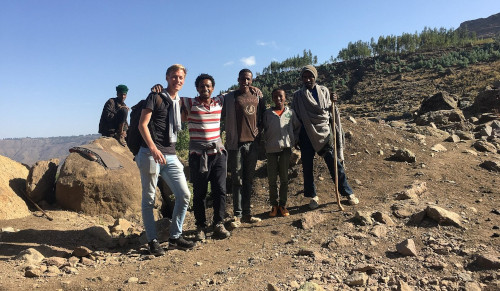|
Trekking
Short
1 Day
2 Days
3 Days

|
Trekking in Lalibela

Abuna Yoseph
walkers and those of us who love to see mountains. Its peak, Rim Gedel, is marked on maps at 4,284 meters, although each time I have been up there our GPS’s made it a round 4,300! Frankfurt Zoological Society have been running a wolf conservation project on the mountain for a number of years to protect the habitat of the Ethiopian Wolf – the world’s most endangered of the dog family. It is a relic from a time when the more familiar wolves ranged this far south during the Ice Age. The retreat north of the ice left wolves in the Ethiopian highlands, with an ever shrinking range area and changing environment. They have now become specialists in hunting in the Afro Alpine moorland – hunting for rodents. The biggest concentration is found in the Bale Mountains far to the south. Next comes the Gwassa Menz highlands east of Addis. A few packs live in the Simiens, Abuna Yoseph, and some other mountains such Aboy Gara, a little to the south of Abuna Yoseph. Since the completion of the new FZS built guest house, Agaw Beret, near the peak, Abuna Yoseph is now once of the best places to see this illusive wolf. This is because you now can stay in the midst of the Wolves range area Your trek up Abuna Yoseph can be best done to end in Lalibela. The trek starts at Geneta Mariam community guest house. Geneta Mariam is 17km off the main road between Lalibela airport and town. You can reach Geneta Mariam on a trek from Eastern Meket site Aina Amba or from Kurtain Washa in Gidan. You can also get dropped at the junction and walk the 17km along a small dirt raod, or pay a little more to be taken to the village of Geneta Mariam itself.
West Meket
West Meket, is the gentlest walking of all the Tesfa treks, although some walks are quite long, they are all mainly on the flat. The altitude is also between 2,800 and 3,000 meterr for the most part, which although it will make you short of breath it will not make you struggle too much! At the trail head is the community lunch stop of Werkhaye Mariam on the edge of a thick Juniper Woodland that surrounds the big Mariam church there. Here the community will serve you enjara and freshly made vegetarian sauces, with coffee or tea. This is welcome after the drive from Lalibela (2 hours) or Bahir Dar (4.5hrs) or Gondar (5.5hrs). From Werhaye you have a three hour walk to most south westerly guest house is Mequat Mariam, a remote parish based around the church of St.Mary’s of Mequat, was the first community guest house to begin hosting late in 2003. The tukuls (thatched round cottages) are set on a promontory of the Meket plateau with staggering views to the west and south. A small troop of Gelada Baboons patrol the escarpment, and a troop of Vervet monkeys sometime come up for a visit. Lammergeyers, vultures, buzzard, kites, ravens and many other birds soar over the site, and a flock of white-billed starlings – endemic to the highlands of Ethiopia are resident by the guest house cliffs. Mequat Mariam boasts a ‘rock bar’, a smooth sheltered ledge that is warmed by the afternoon sun and invites guests to sit with a sundown drink a watch the golden glow at the end of the day turn red as the sun sets over Mount Guna. From Mequat it is approximately 7 hours walking to the second community guest house: Wajela. The walk takes you along escaprment edges and across meadows/fields. On the way you will stop for lunch at Meskal Mikael, also a beautiful place with dramatic views. For several months after the rainy season ends there is a waterfall off the cliffs near here. Its also a great baboon spotting location. Here you will get a lunch on enjara and vegetable wots, with a coffee ceremony to follow.
East Meket and Gidan
This area is to the East of the road from Gashena to Lalibela and the plateau goes gradually higher and becomes more rugged. The community guest house that links east and west Meket is Yadukulay. This guest house is a great starting point for treks to the east. More details about Yadukulay can be found on West Meket page. From Yadukulay (approx 2,600m) the trail into East Meket takes you down over a river, and up a steep escarpment. The trail crisscrosses up the slope, its a steep climb but does not take long until you emerge on the plateau top. Enjoy the well earned views and then carry on along the escarpment, gradually going upward to the community run lunch stop at Dufti Mariam. The altitude here is about 2,900m. There are great views from here, but still some walking to go as the plateau rises slowly to Boya Mikael, a remote Community Guest House at around 3,200m. Some of the trek takes you into the plateau in an areas surrounded by hills rising up from the plateau base. Boya Mikael guest house is set on the edge of a jutting out part of the escarpment, with an amazing sunset view. From Boya Mikael the walk to Aina Amba heads eastwards and follows the plateau – parts of the walk along the edge of the escarpment with great views across the valleys towards the massif of Abuna Yoseph standing just behind Lalibela. Other parts of the walk are along the fields on the op of the plateau with all the farming life that goes on. On the way if its a Monday you will stumble across a market set up in the middle of these fields at Waro Mikael, Waro is also the location of the community run lunch stop on the trail – a spot with the customary good views and simple local food. From Waro the trail follows the escarpment edge to Aina Amba, this is prime Gelada Baboon territory, hundreds of these photogenic apes live on the escarpment edges where they can quickly escape danger. They are great crop raiders so in the season when the crops are maturing ahead of the harvest the farmers are fighting to keep them away. Aina Amba is built on a slight rise, on the north facing escarpment – there is a wonderful sunset looking over to Abuna Yoseph. Its quite high here – around 3,300m From Aina Amba you can be picked up (or dropped off) as the road comes within a couple of km of the guest house, its about a 2hr drive to/from Lalibela. There are two trails from Aina Amba, one continuing eastwards on the increasingly rugged and higher plateau to the community guest house at Kurtain Washa, the other down into the valley to the north, fording the two rivers, and climbing up to Geneta Mariam [Link] on the lower part of one of the spurs coming from Abuna Yoseph. The walk to Kurtain Washa takes a full day with a break for lunch at the community lunch stop at Melkidefer. It is one of the most beautiful walks with changing views as the valley below becomes narrower and turns into a narrow gorge. There is unusual vegetation too with some lovely Giant Heather (Erica arborea) woodland near Melkidefer and the pretty church of Adisge. There are often fields of red hot pokers – a sure sign that the altitude has increased, along with the carpet of wild thyme under foot. After lunch the scenery becomes ever wilder and feels more remote and high. This is still good Gelada Baboon territory, but you also stand a good chance to see other wildlife, klipspringer, hyrax, jackals etc. And as all along these escarpments mighty birds of prey can be seen soaring in the thermals: Lammergeyers, Black Eagles, vultures of various types etc. Kurtain Washa is the most recently set up community guest house – using the pervading local style for more oval less circular buildings, it is perched on a hill with commanding views west back down the gorge. It is set at an altitude of around 3,500m. From Kurtain Washa it is a two hour walk out to the main road at a town called Ahun Tegegne, or a tough but wonderful walk down into the valley that separates the escarpment from Abuna Yoseph, the Tekeze Valley. The walk will take you down to the small town (big village) of Kulmesk, where you can have lunch at a local eatery, before setting off along the small dirt road to Geneta Mariam. its a long days walk, not for the faint hearted, but a great day if you are up for it.
|

